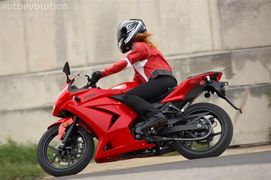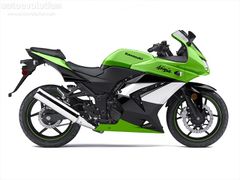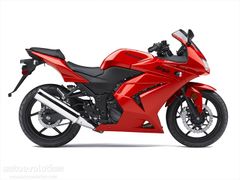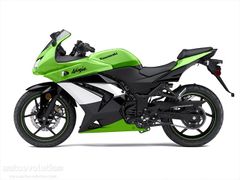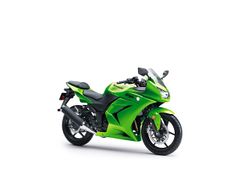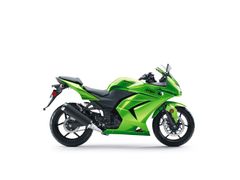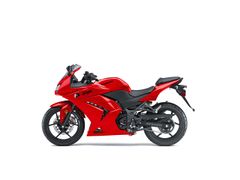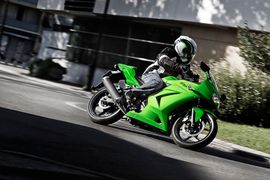Kawasaki EX250J
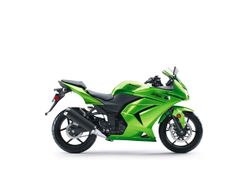 |
|
| Kawasaki EX250J | |
| Manufacturer | |
|---|---|
| Also called | Kawasaki Ninja 250R |
| Production | 08 |
| Class | Sportbike |
| Predecessor | Kawasaki EX250F Ninja 250 |
| Successor | Kawasaki EX300 Ninja 300 |
| Engine | |
| Bore / Stroke | 62.0 × 41.2 mm (2.44 × 1.62 in.) |
| Compression ratio | 11.6 : 1 |
| Top Speed | 96 mph |
| Fuel System | Carburetor: Keihin CVK30 x 2 |
| Spark Plug | NGK CR8E [1] |
| Transmission | 6-speed, return shift |
| Final Drive | Chain: 520x106 |
| Front Sprocket | 14T |
| Rear Sprocket | 45T |
| Front Tire | 110/70-17 [1] |
| Rear Tire | 130/70-17 [1] |
| Wheelbase | 1400 mm (55.12 in) |
| Length | 2085 mm (82.09 in) |
| Width | 715 mm (28.15 in) |
| Height | 1110 mm (43.70 in) |
| Weight | 335 lb (152 Kg) (dry), |
| Oil Capacity | 1.7 L (1.8 US qt) |
| Oil Filter | K&N KN-112 |
| Recommended Oil | K-tech 10W-40 |
| Fuel Capacity | 4.8 US gal (18.0 L) |
| Manuals | File:2009-kawasaki-ninja-250r owners manual.pdf File:2008 Kawasaki EX250J owners manual.pdf File:2008 Kawasaki EX250K owners manual.pdf More Manuals |
In 2008, Kawasaki gave the EX250 its most thorough modernization in many years. The EX250-J model is known as the Ninja 250R worldwide. Kawasaki increased the MSRP by $500 U.S.D., to $3,499 in 2008, by an additional $500 U.S.D. to $3,999 in 2009, and a further $300 to $4299 for the 2010 model year.
Description[edit | edit source]
Parts from the third generation are still found on the -J, but its redesigned exterior panels bring the smallest Ninja's appearance out of the '90s and into line with late-2000s sportbikes. The engine and drivetrain retain 30% of the -F model's parts, according to Kawasaki literature. The engine's compression and maximum torque have been lowered to provide better midrange performance, where the motorcycle spends most of its time. The redesign of the engine was a response to frustration felt by new riders, according to Kawasaki, resulting in improvements in engine response at low RPM, and making the bike smoother and "much easier to ride."[2] Though the previous generation Ninja 250 had one more peak horsepower, or five more peak engine horsepower according to official Kawasaki specifications,[3][4] according to testing by Motorcycle Consumer News,[5] the new version's 20 or 30 percent increase in mid-range power allows the bike to pull from 3,000 rpm where previously it had to be revved to 4,000.[6] The U.S.-spec -J model uses dual carburetors like the -F model, but the European-spec, Brazilian-spec and Thailand-spec model have a fuel-injection system. The wheels were increased in size to 17", the front suspension was beefed up, and the brake rotors were replaced with a larger "petal" design. A fuel gauge was put in place of the previous model's temperature gauge, except on the Brazilian model. With the additional and redesigned equipment, the EX250-J suffered a ten kilo increase in wet weight over its predecessors.
With the arrival of the EX250-J, manufacturing continues to be located in Thailand.[7]
2009 Kawasaki Ninja 250R[edit | edit source]
The Kawasaki Ninja 250R is a street motorcycle sold by the Kawasaki Motors division of Kawasaki Heavy Industries since 1983. It is Kawasaki's best-selling motorcycle, experiencing steady double-digit sales growth year after year. It is renowned for its light handling, good fuel economy, sufficient power, and relatively comfortable riding posture, making it a desirable first motorcycle for new riders, and a popular machine with experienced riders who seek a second machine, or wish to enter the sportbike category. The smallest Ninja has undergone few changes throughout its quarter-century existence, having seen only two substantial redesigns.
2012 Kawasaki Ninja 250R[edit | edit source]
Whether you are an experienced rider or a first-time motorcycle owner, the 2012 MY Kawasaki Ninja 250R is almost sure to satisfy your needs. Combining almost supersport like speed and acceleration with smooth torque delivery at low revs, this new Ninja will satisfy almost any need a rider would have, all at a pretty decent price tag.
Even though it has only a 249cc liquid-cooled, parallel twin engine, which might seem small, when you add the modern and aerodynamic bodywork and the 17-inch sportbike wheels, you get a motorcycle that is agile like its bigger siblings in the family, but also comfortable and with superb handling, ideal for busy city streets.
And because the quarter-liter Ninja is supposed to be also more affordable for younger riders, seeing Kawasaki going for a two-carb fuel delivery system is only natural.
References[edit | edit source]
- ↑ 1.0 1.1 1.2 2008 Kawasaki EX250J owners manual. Kawasaki.
- ↑ Ets-Hokin, Gabe (June 2008), "Small Fortune; 2008 Kawasaki Ninja 250R Cycle World Test", Cycle World 47 (6): 76, ISSN 011-4286
- ↑ Cite error: Invalid
<ref>tag; no text was provided for refs namedofficialGPXservicemanual-supplement - ↑ Cite error: Invalid
<ref>tag; no text was provided for refs namedkawiofficialspecs - ↑ Santos, Franke (June 2008), "Model Evaluation Kawasaki Ninja 250R", Motorcycle Consumer News (BowTie, Inc.): 16–19, archived from the original on May 1, 2009 5:24:05 PM, http://209.85.173.132/search?q=cache:yW88Oh2I2GAJ:www.mcnews.com/mcn/features/200806ninja.pdf&, "...the older model makes one more horsepower than the new one [...] The older model actually makes more peak horsepower than the new model: 27.46 @ 12,000 rpm for the ’04 vs. 26.40 @ 11,000 rpm for the ’08." Note: MCN dynamometer data is rear-wheel only.
- ↑ Cite error: Invalid
<ref>tag; no text was provided for refs namedMCN - ↑ 2008 Kawasaki Ninja 250R - First Ride. MotorcycleUSA.com, 2/12/2008, Bart Madson.
| ||||||||||||||
